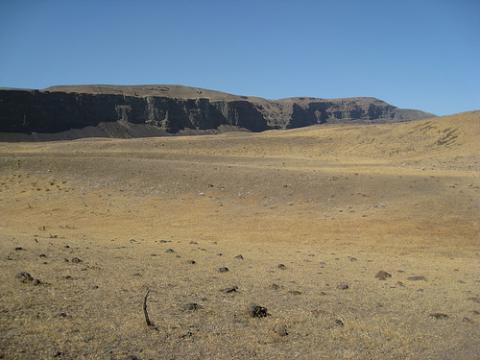The Omnibus Public Land Management Act of 2009 established three National Scenic Trails -- the Pacific Northwest National Scenic Trail, the New England National Scenic Trail, and the Arizona National Scenic Trail. The much-awaited scenic trails have generated a good deal of buzz. For example, some are saying that the new Pacific Northwest Trail may rival the renowned Pacific Crest Trail within a decade. Pretty much lost in all the hoopla is the fact that this year’s public lands act also established the country’s first-ever national geologic trail.
The Ice Age Floods National Geologic Trail, actually a network of routes in Washington, Oregon, Idaho, and Montana, is designed to interconnect historic sites, parks, and other facilities interpreting the geologic consequences of the Glacial Lake Missoula Floods. And my, what geologic consequences they were! The Missoula Floods, a series of several dozen immense floods resulting from the sudden draining of a giant ice-dammed lake many thousands of years ago, scoured vast amounts of sediment and rock from the eastern Washington scablands, created many unique landforms, and carved the impressive Columbia River Gorge. And all of this was done so quickly it defies the imagination.
It was a pretty awesome system that stored enough energy to do this work. Glacial Lake Missoula, which formed in western Montana at various intervals during a period extending from about 13,000 to 15,000 years ago, was perhaps the largest of all the ice-dammed lakes we now of. It formed when lobes of the Cordilleran Ice Sheet that extended southward from Canada and along the spine of the Rockies blocked the Clark Fork River with ice dams soaring 2,000 feet high. The 200-mile long lake that backed up behind thee ice dams contained about 500 cubic miles of water, or about half the volume of present-day Lake Michigan.
When the dam was breached, an event that is thought to have happened about every 40 to 140 years during the span of two millenia, the immense torrents of water that gushed out were some of the biggest floods this planet has ever produced. The largest of the floods discharged an estimated 2.6 billion gallons of water per second. Each of the great floods packed enough kinetic energy to accomplish, in a mere geologic eye blink, erosion that would take normal geologic forces many thousands of years to accomplish.
Trail supporters, especially in the state of Washington, campaigned more than 15 years to make the new geologic trail a reality. It’s expected that the trail, which will traverse public lands and minimally impact private lands, will generate many economic and cultural benefits in the four-state region encompassed by the project.
To see a map of the new trail (at the proposal stage) and get additional relevant information, visit this Ice Age Floods Institute site.
The National Park Service will administer the Ice Age Floods National Geologic Trail, but the trail will not be counted as a unit of the National Park System.
Postscript: The lower St. Croix River in the St. Croix National Scenic Riverway near Minneapolis-St. Paul, Minnesota, has a notch-shaped profile in places. Those miniature canyons were carved by cataclysmic floods gushing from ice dammed lakes similar to (but smaller than) prehistoric Lake Missoula.


 Support Essential Coverage of Essential Places
Support Essential Coverage of Essential Places







Comments
For the past several years, the National Parks Conservation Association (NPCA) has worked with the Ice Age Floods Institute and the Washington State Congressional delegation to see the creation of this trail. We look forward to its completion.
The implementation and management of the Ice Age Floods National Geologic Trail will present to the public the story of the greatest outburst floods known to science. These cataclysmic geologic events were known only to professional geologists until recent decades. As the public has become more aware this amazing story, the demand for more interpretive facilities, tours and information has grown dramatically.
The trail will link existing and future federal, state, local, private and tribal interpretive facilities into a comprehensive scientific presentation of the Ice Age Floods. This trail will be managed by the National Park Service.
In a day and age where rural communities are struggling to find new revenue sources and are becoming more and more reliant on tourism, economically the Ice Age Floods National Geologic Trail will be a boon for rural communities across the northwest. In a report funded by the National Park Service, researchers estimate this park unit will help contribute over $1 billion in tax revenue, over $18 billion in travel spending and over one quarter of a million jobs in the four state region.
The rapid draining of Lake Missoula was not the largest flood event, but left some of the clearest signs still visible. When Lake Bonneville broke Red Rock pass in Idaho (not ice dam, probably cut through volcanic cap over softer material) it drained something like 1000 cubic miles of water in a few weeks. Lake Agassiz held over 2000 cubic miles of water in what is now Minnesota, North Dakota, Manitoba, & Ontario, but I don't know how fast it drained when it got an outlet to the north (it didn't leave as clear of evidence), and I suspect that the St. Croix NSR wasn't part of the drainage.
I look forward to seeing the education & interpretation Ice Age Floods produces.
You are quite right, tomp. I should have written "some of the biggest" rather than "the biggest." Big difference there.
And wasn't the Mediterranean Sea a dry below-sea-level depression until about 5 million years ago when the Atlantic ocean broke through the Gates of Hercules and flooded it? ;-)
Keep going, you guys. You got your Black Sea flood, your Genesis flood, .......